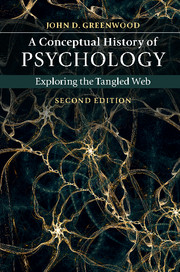Book contents
- Frontmatter
- Contents
- Preface
- 1 History, science, and psychology
- 2 Ancient Greek science and psychology
- 3 Rome and the medieval period
- 4 The scientific revolution
- 5 The Newtonian psychologists
- 6 Physiology and psychology
- 7 Theories of evolution
- 8 Psychology in Germany
- 9 Psychology in America: the early years
- 10 Functionalism, behaviorism, and mental testing
- 11 Neobehaviorism, radical behaviorism, and problems of behaviorism
- 12 The cognitive revolution
- 13 Abnormal and clinical psychology
- Epilogue: the past and future of scientific psychology
- Index
- References
6 - Physiology and psychology
Published online by Cambridge University Press: 05 September 2015
- Frontmatter
- Contents
- Preface
- 1 History, science, and psychology
- 2 Ancient Greek science and psychology
- 3 Rome and the medieval period
- 4 The scientific revolution
- 5 The Newtonian psychologists
- 6 Physiology and psychology
- 7 Theories of evolution
- 8 Psychology in Germany
- 9 Psychology in America: the early years
- 10 Functionalism, behaviorism, and mental testing
- 11 Neobehaviorism, radical behaviorism, and problems of behaviorism
- 12 The cognitive revolution
- 13 Abnormal and clinical psychology
- Epilogue: the past and future of scientific psychology
- Index
- References
Summary
The nineteenth century was a time of great change in Europe and America. Agricultural reforms ensured a steady food supply, and improvements in public hygiene decreased fatalities from contagious diseases such as cholera. The population of Europe increased from about 140 to 420 million people between 1750 and 1900, with many congregated in the new urban centers. The dramatic expansion of industry led to a general increase in wealth, although the insecurities of the capitalist state (with periods of boom followed by periods of economic downturn) led some to question a system in which most of the wealth was owned by a privileged few and to look to alternative political systems such as socialism and communism. New developments in transportation and communication saw the spread of modern road networks, railways, canals, ocean lines, and telegraph and postal systems (Jansz, 2004).
The nineteenth century witnessed the growth and increasing political strength of the middle class, whose long struggle to attain voting rights eventually bore fruit, although throughout most of the nineteenth century real political control remained in the hands of the conservative aristocracy. In the reactionary period following the Napoleonic wars in Europe, which ended with Napoleon's defeat at the battle of Waterloo in 1815, naturalistic approaches to psychology were repressed through censorship and the secret police. Nobody who promoted such views could hold a professorship in Europe and America in the early half of the century, and in the years immediately following 1815, advocacy of such views was punishable by imprisonment in some parts of Europe (Reed, 1997).
As noted earlier, Joseph Priestley (1733–1804) was hounded out of Britain for his promotion of Hartley's associationist psychology as materialist psychology. Erasmus Darwin (1731–1802), the grandfather of Charles Darwin (1809–1882), who developed an early naturalistic evolutionary theory in Zoonomia (1794–1796), found his work suppressed. One of Darwin's followers, the British surgeon William Lawrence (1783–1867), published his theory that insanity is a neurophysiological disorder in Lectures on Physiology, Zoology and the Natural History of Man (1819). The medical establishment forced him to withdraw his book, and he lost his lectureship at the Royal College of Surgeons (Reed, 1997).
- Type
- Chapter
- Information
- A Conceptual History of PsychologyExploring the Tangled Web, pp. 139 - 184Publisher: Cambridge University PressPrint publication year: 2015



